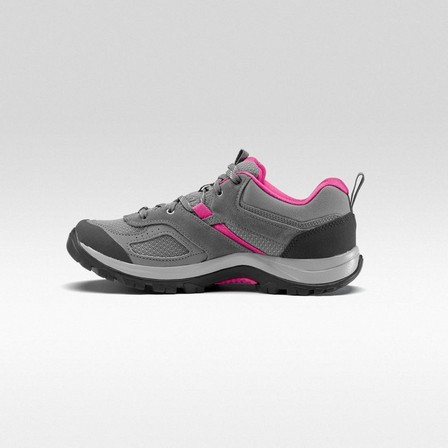QUECHUA
Women Mountain Walking Shoes - Mh100, Multicolour
Details
https://www.azadea.com/qa/en/buy-quechua-mountain-walking-shoes---mh100-pewter/54_8397088_000.htmlChoose one or more sizes to check their availability in stores :

Free Returns
Within 30 Days
Offers
Description

These Shoes Are Made For Occasional Hikes In The Mountains In Dry Weather. Designed At The Foot Of The Mont Blanc.
Gives Your Feet Comfort And Protection Thanks To The Cushioning Along The Length Of The Sole, The Protective Stone-Guard And A Gripping Sole.
Traction
Non-Slip Rubber Outsole With 4Mm Gripping Studs.
Impact Protection
Durable Rubber Stone-Guard At The Front Of The Foot To Protect Your Toes.
Cushioning
Full-Length Cushioning Thanks To An Eva Midsole
Lightweight
295 G Per Shoe In Size 6
QUECHUA
Women Mountain Walking Shoes - Mh100, Multicolour
Highlights
Composition
Outer Sole Of
70% Synthetic Rubber
30% Ethylene Vinyl Acetate
Upper Of
20% Polyurethane
60% Polyester
20% Leather - Bovine - Split
Lining And Sock Of
10% Polyamide
90% Polyester
What Is Your Hiking Frequency And Intensity?
We Have Classified Our Products In Terms Of Performance And Features For 3 Levels Of Mountain Walking:- Occasional: About 10 Hikes Per Year Of About 3 To 4 Hours In Length, Covering Less Than 10Km And Less Than 700M In Elevation Gain.- Regular: About 20 Outings Per Year. 4 To 6 Hours, 10 To 20 Km, 700 To 1200M Of Elevation Gain Per Outing.- Intensive: More Than 20 Times A Year. More Than 6 Hours, More Than 20 Km, 1200 To 2000M Of Elevation Gain Per Outing.
Sustainable Development Information
For The Inner Sole Fabric Coating Of These Boots, We Dye The Thread During Manufacturing To Reduce The Environmental Impact. Textile Dyeing Requires A Lot Of Water But Also Produces Waste Water From The Dye Baths. To Reduce This Environmental Impact, We Use A Mass Pigmentation Process That Involves Adding The Colour Pigments When The Yarn Itself Is Produced.
Sole With Grip
The Grip Of Our Soles Is Certified. To Be Awarded Certification, The Boots Must Pass Laboratory Tests To Assess The Grip Rate On Different Surfaces (Smooth, Rugged, Dry, Wet). To Validate These Tests, We Assess The Quality Of Our Soles In The Field, In The Mountains, By A Panel Of Representative Testers Over 500 Km
Which Size Should I Select?
The Most Important Thing Is To Try On Several Sizes And Styles Of Boots To Find The One Most Suited To You! You Can Take A Size Above Your Usual One To Prevent The Toes From Bumping Into The Toe Box When Going Downhill, Provided The Foot Is Properly Supported To Avoid Friction. Tip: Keep Your Toenails Short And, Before A Long Descent, Check That Your Lacing Is Tight Enough To Prevent Your Foot From Sliding Forwards Inside The Boot.
Buying Tips / How Do You Try Your Boots On?
Some Decathlon Stores Have A Test Route.
1. Try On Both Shoes, Standing Up, With The Socks Worn For Hiking.
2. Tighten The Laces, Taking Care To Correctly Balance The Tightening.
3. Check Two Points:- The Heel Does Not Come Up Before The Boot When You Walk Uphill.- The Foot Does Not Slide And The Toes Do Not Press Against The Front When Going Downhill.4. Try On Several Sizes And Models. Break Them In Gradually To Adapt Them To Your Foot.
Field Tests
All Our Shoes Are Tested For Initial Comfort And Comfort In Use By Hikers (Who Do Not Work For Decathlon) Under The Same Conditions You Will Encounter Yourself When Hiking. The Aim Is To Further Develop The Product And Validate It As Objectively As Possible, For Your Greatest Satisfaction.
Lab Tests
Further Laboratory Tests Were Conducted To Test The Following Elements: Attachment Of Eyelets And Webbing, Assembly, Toxicology, Uv Resistance, Sole And Upper Component Abrasion, Accelerated Ageing.
Optimise The Capabilities Of Your Boots: Replace Your Insoles!
The Original Insole In Your Boots Is Designed To Accommodate Most Feet. A Change Of Insole Can Bring:
1. Improved Support: Some Soles Are Preformed Or Reinforced To Better Support The Arch Of The Foot.
2. More Comfort: The Insoles Can Also Provide Heat And/Or Cushioning.
3. Longer Life: Restore The Support And Comfort Of Your Shoes By Replacing The Insole Each Season.
How Do You Avoid Blisters?
Blisters Generally Develop When The Skin Is Weakened By Friction. In Order To Prevent Them From Occurring, We Recommend The Following:
- Choose A Shoe In Your Size.
- Wear Suitable Socks
- Tie And Tighten Your Shoes Properly
- Do Not Hesitate To Readjust Your Lace Fastening During Activity, Particularly Before Tackling A Climb Or Descent.
- Wear Your Shoes On A Short Trip For The First Use.
How Should You Look After Your Boots?
- Leave To Air Dry.
- Remove Dry Mud With A Stiff Brush.
- Clean Marks Using A Brush And Some Warm Water
- Leave To Dry
- Spray With A Re-Waterproofing Product To Restore The Water
- Resistance To The Upper.
Specifications





























